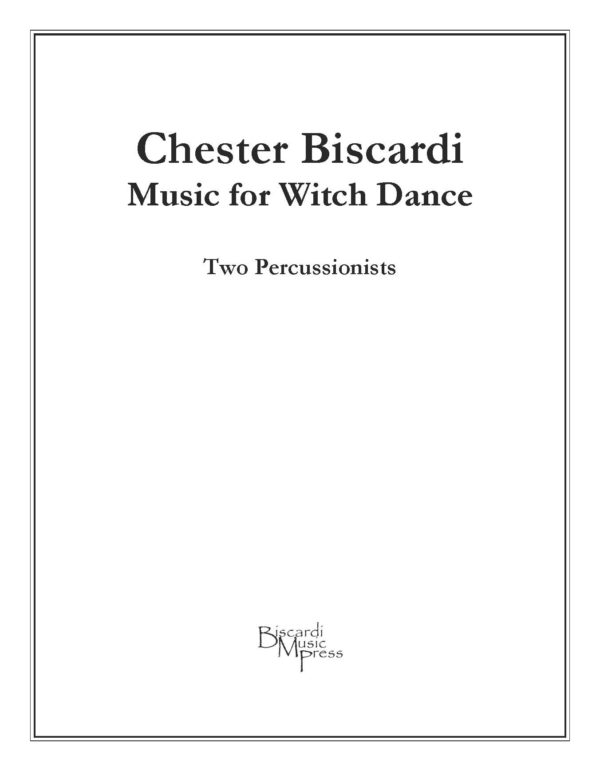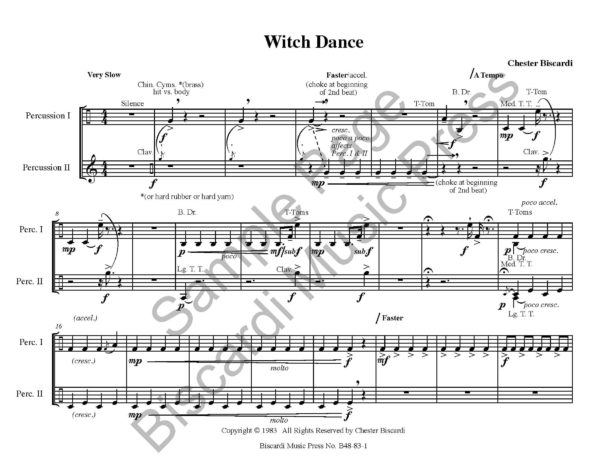Description
Premiere
16-20 March 1983
Glen Velez and Peter Alexander, percussionists / Annabelle Gamson, dancer
The Joyce Theater
New York, NY
Videotape: Annabelle Gamson, Phyllis Lamhut, Don Redlich in concert; videotaped in performance at the Joyce Theater, New York, on March 18, 1983, by Video D Studios; Witch Dance (ca. 8 min.); choreography, Mary Wigman (1926), Annabelle Gamson (revised version, 1983; danced by Annabelle Gamson; music, Chester Biscardi ; Glen Velez and Peter Alexander, percussionists; mask, Ralph Lee; lighting, Richard Nelson; camera, Dennis Diamond
Instrumentation
Perc I [Crotales, Bass Drum, 4 Tom-Toms, Bongos, Large Tam-Tam, Temple Block, 2 Chinese Cymbals, Sizzle Cymbal, 3 Suspended Cymbals, Hi-Hat]; Perc II [Crotales, 4 Tom-Toms, Claves, Large Tam-Tam, Medium Tam-Tam, Chinese Gong, Chinese Cymbal, Sizzle Cymbal, 3 Suspended Cymbals, Hi-Hat]
Dedication
Written for Annabelle Gamson's reconstruction of Mary Wigman's Heksedans (1926)
Commissioner
Commissioned by Dance Solos, Inc.
Publisher
Biscardi Music Press No. B48-83-1
Distribution: Theodore Front Musical Literature, Inc.
Program Notes
Music for Witch Dance, for two percussionists (1983), was written for Annabelle Gamson’s reconstruction of Mary Wigman’s Heksedans (1926) based on fragments of the dance recorded in a 1929 film about Mary Wigman and a description of her work in Rudolph Bach’s Das Mary Wigman Büch. The music takes its initial ideas from Willi Goetze’s score of 1926 (also in the film and book), originally consisting of three gongs, drum and cymbal, which stylistically reflects the primitive, childlike nature and austerity of the Expressionist period.
As a dance score the musicians respond to the extreme, striking and dynamic gestures and movements of the dancer in relation to space. Wigman explored the nature of man in relation to his universe, and she considered the stage on which she worked as a portal through which the dancer entered the symbolic sphere of space as universe.
In the middle of a stage filled with harsh, white light, a masked dancer squats motionless and in silence. Her hands hide her face. She reveals herself slowly, backs of hands turning inward, palms outward, lips protrude, secret smile, terrible tension, trembling rigidity, the left arm suddenly pulled in with a jerk as the right arm shoots vertically upwards with its hand reaching into the air like a claw. These movements continue, syncopated, double staccato, sometimes soundless tension, incorporating powerful circular swings of the entire body, jerking of the head, all of which result in a circle dance. At times one hears the bare soles slapping the stage. After a return to the squat position, the dancer works her way out of the circle with fierce tempo, alternating with restrained trembling, moving toward an increased tempo and accelerated finale, leaping and running with a constant circular motion of the arms across the entire stage. Gamson writes: “The body rises up higher and higher out of itself, a quick circle, with arms stretched high as if throwing themselves forward; a furious leaping movement to the back of the stage-space, body faced forward; suddenly a wide straddle-position, the arms rush like lightning to the right and left, crossing each other, as if they had to rip apart something in front of the face. For a moment the figure is like a gleaming, enthroned idol, but the body immediately falls over backwards, a very powerful swing of both arms throws it forwards again, it tumbles back on the ground, the hands supporting it, the head snaps up, the mask stares toward us in petrified madness. Darkness.”
Music for Witch Dance was commissioned by Dance Solos, Inc. and first performed during the opening season of The Joyce Theater in New York City, March 16-20, 1983, with Annabelle Gamson, dancer, and Glen Velez and Peter Alexander, percussionists.









